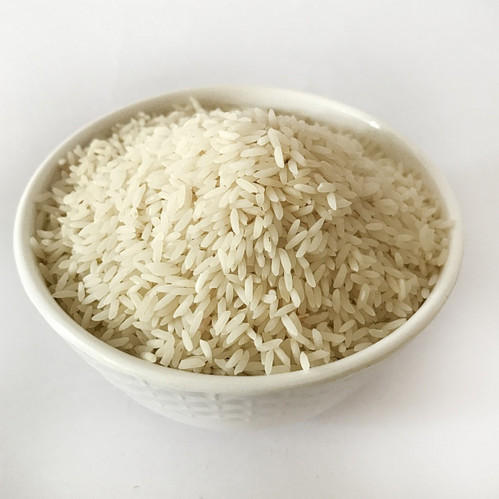Basmati Rice
Basmati rice is a premium long-grain variety famous for its natural fragrance, delicate taste, and fluffy texture. Grown mainly in the Himalayan foothills, it is highly prized for biryani, pulao, and festive meals. Each grain remains long, slender, and non-sticky after cooking, making dishes more appetizing and aromatic. Apart from its culinary charm, basmati rice is naturally gluten-free, low in fat, and packed with essential nutrients. It is light, easy to digest, and suitable for daily meals as well as special occasions. Cherished globally, basmati rice continues to be a symbol of richness, flavor, and quality.
Non-Basmati Rice
Non-basmati rice includes a wide range of short and medium-grain varieties used daily across the world. Unlike basmati, the grains are softer, more starchy, and slightly sticky after cooking, making them ideal for dishes like khichdi, idli, dosa batter, and traditional curries. Affordable and versatile, non-basmati rice is the staple food for millions of households. It cooks quickly and provides essential carbohydrates, keeping the body energized. Rich in nutrients and easy to digest, it is suitable for regular family meals and bulk catering. With its taste, affordability, and variety, non-basmati rice remains a vital choice in everyday diets.
Parboiled Rice
Parboiled rice is partially boiled in its husk, a process that makes it more nutritious and firm than regular rice. It retains more vitamins and minerals compared to polished varieties and is less sticky after cooking. Popular in South India and West Africa, it is widely used for idli, dosa, and large-scale catering. Rich in fiber and complex carbohydrates, parboiled rice supports digestion, provides energy, and keeps you full for longer. With its golden color, non-sticky nature, and nutritional benefits, parboiled rice is a smart choice for both daily meals and commercial food preparation.
Sona Masoori Rice
Sona Masoori rice is a lightweight, aromatic, and medium-grain variety cultivated mainly in Southern India. Known for its soft texture and subtle fragrance, it is a preferred choice for everyday meals, including plain rice, pongal, fried rice, and pulao. Low in starch and calories, Sona Masoori is considered a healthier rice option for daily diets. It is easily digestible and recommended for those seeking light yet nutritious meals. With its versatility, affordability, and delicate taste, Sona Masoori rice is popular in households, restaurants, and global markets alike, making it an essential kitchen staple.
Brown Rice
Brown rice is a whole-grain variety that retains its bran and germ layer, making it more nutritious than white rice. It has a chewy texture, nutty flavor, and is rich in fiber, vitamins, and minerals. Known for aiding digestion, controlling weight, and supporting heart health, brown rice is a favorite among health-conscious people. Although it takes longer to cook than polished rice, the nutritional benefits make it worth the effort. Brown rice is widely used in salads, healthy bowls, pulao, and everyday meals, offering a wholesome and balanced diet alternative.
Steamed Rice
Steamed rice is processed with steam to lock in nutrients, resulting in soft, fluffy, and non-sticky grains after cooking. It is widely used in South India, Sri Lanka, and other parts of Asia as a staple food. This rice is light, easy to digest, and retains more natural vitamins and minerals compared to polished rice. It pairs perfectly with curries, sambar, rasam, and side dishes, making it a household favorite. Nutritious and versatile, steamed rice is a wholesome grain choice for everyday meals as well as large-scale catering services.
Red Rice
Red rice is a nutritious whole grain variety known for its reddish-brown bran layer, nutty flavor, and chewy texture. Rich in iron, antioxidants, and fiber, it is highly beneficial for heart health, digestion, and boosting immunity. Consumed widely in South India, Bhutan, and Sri Lanka, red rice is often used in traditional dishes, porridges, and healthy meals. Its natural red color comes from anthocyanins, compounds that also provide anti-inflammatory properties. Ideal for health-conscious people, red rice is a wholesome and tasty alternative to white rice.
Black Rice
Black rice, also called "Forbidden Rice," is a rare and exotic variety packed with antioxidants, iron, and fiber. It has a deep purple-black color that turns dark purple when cooked, with a slightly nutty and sweet taste. Traditionally reserved for royalty in ancient China, black rice is now prized as a superfood. It is commonly used in desserts, salads, rice bowls, and health-based recipes. Rich in anthocyanins, it supports heart health, digestion, and overall immunity. Nutritious and flavorful, black rice is a premium grain for those who value both taste and wellness.
Jasmine Rice
Jasmine rice is a fragrant long-grain rice variety, mainly grown in Thailand and Southeast Asia. Known for its delicate floral aroma and slightly sticky texture when cooked, it is a favorite choice for Asian curries, stir-fries, and fried rice. The grains are soft, moist, and flavorful, making every meal more enjoyable. Jasmine rice is rich in carbohydrates, providing energy and essential nutrients. It pairs well with spicy dishes and enhances the taste of Asian cuisine. With its unique fragrance and delicious flavor, jasmine rice is cherished worldwide as a premium rice variety.
Glutinous (Sticky) Rice
Glutinous rice, also called sticky rice, is a unique short-grain rice variety mainly used in Southeast Asian cuisine. When cooked, the grains become soft, sticky, and clump together, making it ideal for dumplings, sushi, desserts, and traditional snacks. Despite its name, sticky rice does not contain gluten but gets its texture from natural starch. It is widely consumed in Thailand, Laos, and China as part of cultural and festive dishes. Rich in carbohydrates and energy, sticky rice is a delightful choice for both sweet and savory preparations. Its versatility and special texture make it popular worldwide.








